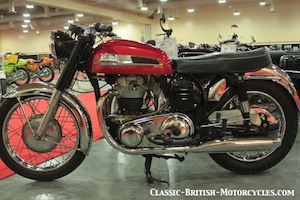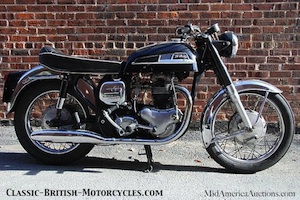EVOLUTION OF THE ATLAS
The Norton Atlas evolved from the Norton Dominator line, which had grown since its inception in 1949 from 500 cc to 600cc then again to 650cc with the fire-breathing twin-carb Dominator 650SS. The Norton Atlas was the next logical step.
The venerable Bert Hopwood-designed vertical twin that had started out life as a 500 was now bored out again to yield yet a higher displacement, this time 745cc. The Norton Atlas 750 was born.
FEATHERBED CONTINUES
It was still carried in the wondrous Featherbed Frame, still competitive & more popular than ever after over 10 years on the market. In fact, a burgeoning cottage industry had sprung up dropping other makers’ engines in Norton Featherbeds. Norvins (Norton frame, Vincent engine) & Tritons (Triumph engine, Norton frame) sprang up. Why such devotion to a frame? The Featherbed Frame was simply the best handling motorcycle frame in the world, by a large margin. Norton really did the job right to begin with, as far back in 1949 at the Isle of Man TT (which Norton won with a Featherbed Manx), so good in fact that the same basic frame would stay in service until 1966, when it was replaced by the 1967 Norton Commando. In its second generation, all Featherbeds were now of the “Slimline”-design (ie: the top frame tubes were brought closer together to form a narrower backbone.
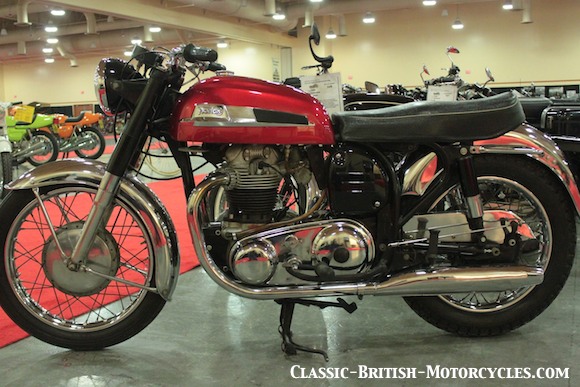
ABOVE: This 1966 Norton Atlas 750 shows why the model was so successful in it’s day. It was a great-looking machine, obviously well-made, with everything ‘just-right’. Great handling & loads of power didn’t hurt either. It’s amazing to consider that this basic engine powered every Norton twin from 1947 until the company’s demise in 1977, a 30-year lifespan. It is truly a testament to the excellence of its design.
EVOLUTION OF THE ATLAS
The Norton Atlas evolved from the Norton Dominator line, which had grown since its inception in 1949 from 500 cc to 600cc then again to 650cc with the fire-breathing twin-carb Dominator 650SS. The Norton Atlas was the next logical step.
The venerable Bert Hopwood-designed vertical twin that had started out life as a 500 was now bored out again to yield yet a higher displacement, this time 745cc. The Norton Atlas 750 was born.
FEATHERBED CONTINUES
It was still carried in the wondrous Featherbed Frame, still competitive & more popular than ever after over 10 years on the market. In fact, a burgeoning cottage industry had sprung up dropping other makers’ engines in Norton Featherbeds. Norvins (Norton frame, Vincent engine) & Tritons (Triumph engine, Norton frame) sprang up. Why such devotion to a frame? The Featherbed Frame was simply the best handling motorcycle frame in the world, by a large margin. Norton really did the job right to begin with, as far back in 1949 at the Isle of Man TT (which Norton won with a Featherbed Manx), so good in fact that the same basic frame would stay in service until 1966, when it was replaced by the 1967 Norton Commando. In its second generation, all Featherbeds were now of the “Slimline”-design (ie: the top frame tubes were brought closer together to form a narrower backbone.

ABOVE: The Atlas 750 engine was essentially a bored-out 650 Dominator twin, which itself was punched out from a 500. Despite all the growth, it was a robust and powerful engine. Note that the cylinders are vertical on the Dominator and Atlas, but canted forward on the soon-to-be-released Commando, which in turn was punched about again to an 850.
TOO MUCH IS ALMOST ENOUGH
The Norton Atlas was really intended for & influenced by the lucrative US motorcycle market. Always hungry for more & more power, the American view was “Too much is almost enough” & engineers from Triumph, BSA & Norton scrambled to comply. And the new Atlas certainly filled that role well, with 55hp at 6500 rpm with a single Amal Monobloc 376 carb.
FICKLE MARKET
But more displacement, more power, more speed, even that wasn’t enough. It had to look right too. Take the 1959 Triumph Bonneville for example. Fickle American buyers shied away from the new Bonnies because they came clad in the big fenders & headlight nacelle of the Triumph Thunderbird, rather than the stripped-down look of the TR6. Triumph learned quickly that speed alone won’t sell an ugly bike. By 1960, the Bonneville looked just like the TR6 & they remained sister-bikes for the rest of their lives.
HIGH STYLE
Norton Motorcycles always had a flair for style anyway. But now they were really building for the export (read that American) market, so they were styled with small 2-1/2 gallon tanks, high handlebars & chrome fenders. They were handsome machines indeed.
VIBRATION BLUES
But Norton was experiencing the same problems that everyone else building vertical twins was: as displacements & power output grew, so did the problem of vibration. Triumph used to fiddle with flywheel weight & crankshaft balance factors constantly in their efforts to deal with their own vibration demons. Norton’s answer was to drop compression to 7.6:1. But the vibration would continue, leading to the development of the ultimate solution: Isolastic Suspension.
Much of the running gear was carried over from the Norton Dominator series including the excellent Roadholder front forks & adjustable Girling rear shocks. The Atlas debuted in 1962 with 6-volt electrics, but was upgraded to 12-volt in 1964. Also in 1964, the Atlas grew a second carburetor & wider fork yokes.
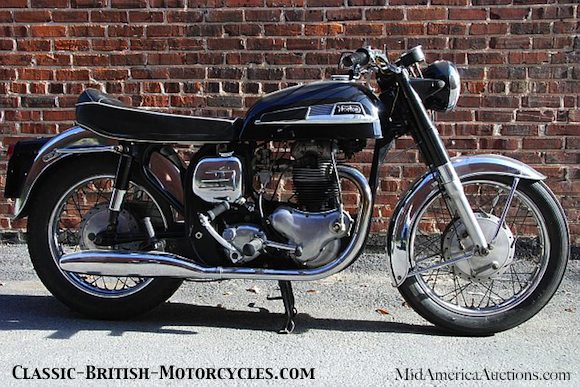
ABOVE: 1967 Norton Atlas 750. Last year of Norton Atlas production overlapped start of Norton Commando production.
RUNNING GEAR
The Norton Atlas 750 was a fast, great handling, very good-looking motorcycle that stacked up well against its contemporaries from Triumph & BSA. Norton Motorcycles in general & the Norton Atlas in particular, always seemed to have a higher-end, more upper-crust (ie: more expensive) image that might have been as much about their inability to compete on price because of their outdated & antiquated manufacturing methods. Either way, they gave us some wonderful machines. And the market today for old Norton Motorcycles has never been stronger.
Norton Atlas SPECIALS & HYBRIDS
Due largely to the exceptional handling of the Norton Featherbed frame, many specialist tuners began building highly customized race bikes. Some even built their own frames. Dunstall produced Atlas-based race bikes among others.
Norton was part of the AMC (Associated Motor Cycles, Ltd) empire until their collapse in 1966, when they were acquired by Manganese Bronze Holdings (who also owned Villiers). During Norton’s AMC years, several models were produced that dropped a Norton Atlas engine in an AMC-derived (read that Matchless-AJS) frame. These were called “Hybrids” because of the obvious cross-pollenization. One example of these hybrids is the Norton P-ll, which used an Norton Atlas 750 engine in a Matchless frame & turned it into an off-road scambler that was much prized then & now.
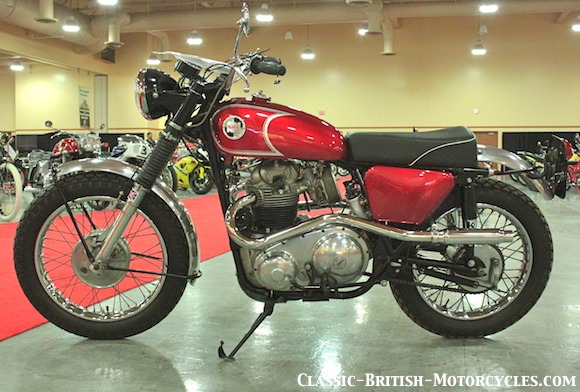
ABOVE: The 1968 Norton P11 was the final year of production.
Norton Atlas YEAR-BY-YEAR
Punched out to 750cc, sporting the Featherbed frame, the Atlas was fast and handled well.
A few years in, the Atlas continues to get faster & better looking.
The 750 Atlas was one of the fastest bikes on the street in 1967, but vibrated badly at high RPMs.
Check out these NORTON BOOKS
Norton Motorcycles: From 1950 to 1986 (British Motor cycles since 1950)
Norton Commando: The Complete Story (Crowood Motoclassic Series)
The Norton Commando Bible: All models 1968 to 1978
The Illustrated History of Norton Motorcycles (English and Spanish Edition)
Norton (Osprey Collector’s Library)
Norton Dominator Performance Portfolio 1949-1970
Norton: The Complete History (Crowood MotoClassics)
For more like this, please visit our
 |
PLEASE BUY MY NEW E-BOOK HERE 12 Chapters & over 100 original photos. My best work yet. ONLY $4.99! Thank you, Andy Tallone, your humble author Click here to buy now: |




